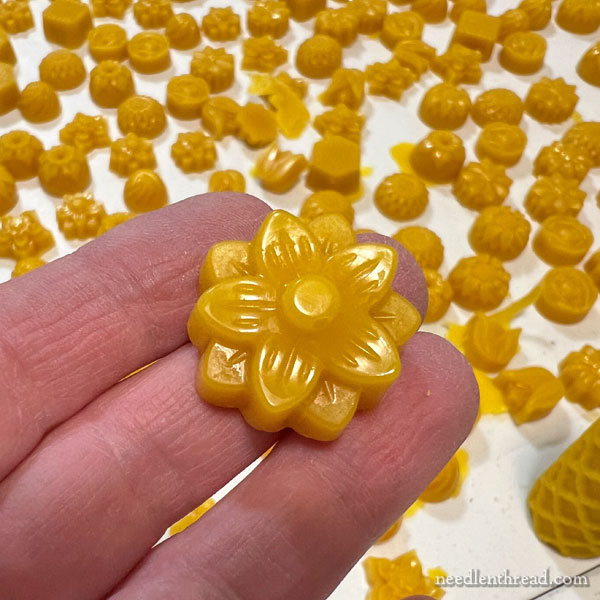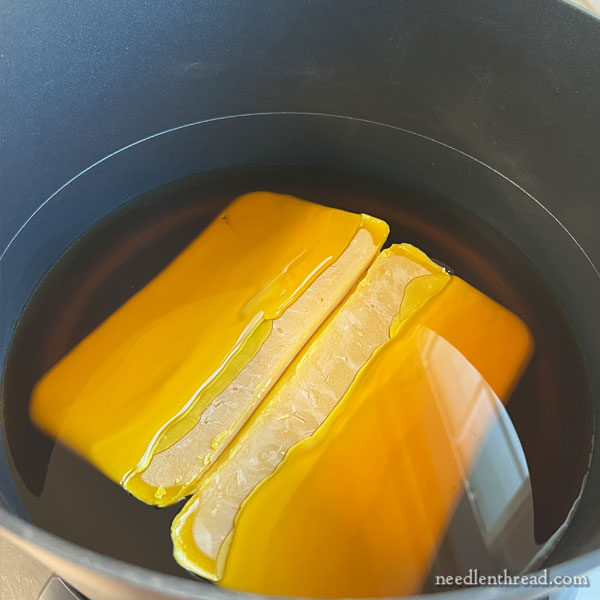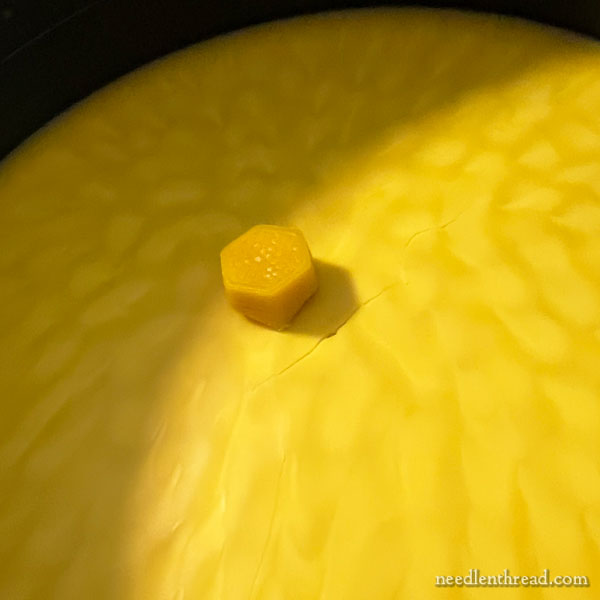Night time, this time of year, is dark.
And while there are many, many people in the world who don’t like the switch back to Standard Time, I must secretly admit that I’m not one of them.
I actually like it – once I adjust!
Don’t get me wrong. I don’t like the time switch in general. But I see it this way: it’s not Standard Time’s fault. It’s the switch to Daylight Savings Time in the spring that’s the problem. If we just stuck with Standard Time, the gradual lengthening and shortening of days would follow the regular rhythm of life and the seasons. And it wouldn’t be a jolt every time there’s that dagblasted hour switch.
But I digress…
Recently, I’ve been re-discovering the hidden pleasure of evening work.

About four years ago, we launched our own collection of Beeswax Petites to use for needlework. I wrote about them in detail here. They sold out quickly – really quickly.
Given the amount of time it takes to do this kind of manufacturing – not to mention the mess, the clean-up, and so forth – it’s been a while since I’ve been able to get back to it.
Now, you might think it’s odd that a needlework-obsessed gal would include beeswax in part of her focus. And perhaps it is, but there’s a good reason for it.
Why I Took it Up
Besides the fact that I love honey and bees and beeswax, besides the fact that there’s a hive sitting in my backyard, besides the fact that there’s nothing quite so pretty and calming as a burning candle made from 100% pure, carefully filtered, naturally scented beeswax… as a needleworker, I’ve always been frustrated with beeswax as it has been presented in the needlework industry.
In short, the common beeswax that you find commercially available as a sewing notion pretty much stinks.
Ok. Literally, it does not stink. It doesn’t normally have any smell. It is not the beeswax-of-pleasurable-evenings-of-work.
Encased in hard plastic, it’s hard to get at. It’s flaky and leaves wax-dandruff on your fabric. It doesn’t absorb that great into thread without some serious work. It is hard-hard-hard (and practically impossible to warm up in your hands). I’ve broken more threads using those commercial wax disks…
I started playing with beeswax – with good beeswax – because I wanted better beeswax for needlework.
Beeswax & Needlework
Once upon a time, it used to be common to find a bit of wax in any needleworker’s toolbox. Beeswax has been used in the needlework world for centuries and centuries.
Coating a thread with beeswax strengthens the thread. When working with metal threads, with beads, even with couched metallics, beeswax acts as a buffer against abrasion.
Even if you’re simply replacing a plastic, metal, or bone button on a shirt or a coat, coating your sewing thread in beeswax ensures that you won’t have to replace that button again for a long while (if ever)! It helps the thread do its job.
Primarily, then, beeswax is used for strength and protection.
I’ve written a bit about beeswax and needlework and how beeswax is used with needlework over the years. If you’d like to read some of those older articles, you’ll find them here:
Mind Your Own Beeswax – for Needlework!
On Thread Conditioning & Beeswax for Embroidery – this article focuses on the point that beeswax is not a thread conditioner.

Back to my evening work…
I’m particular grateful for the fact that I have a wonderful supply of beeswax to work with, some of which is local, coming from the hive in my own backyard and my sister’s backyard.
This particular batch of wax I’m working with is the best I’ve ever used. It is immeasurably fragrant. It’s quadruple filtered. When melted, there’s no cloudiness or residue – it’s a clear, deep golden honey color that pours in a rich stream and oh… it smells heavenly.
I wish I could make the pictures here scratch-and-sniff for you!
But even better than that is this point: for needlework, this batch of wax is remarkable! Because the bees really put forth the effort and produced such a great quality of wax, it’s just lovely to work with. It’s easy to draw the thread through it – it softens just right in the hand, so that the wax works into the thread with very little effort and no flakiness.
Mmmmm. It’s just …. delicious.

And despite the time it takes to work up these little petites – all the melting, and then molding, and then cleaning up each individual piece as necessary, preparing the packaging and packaging them – it is one of my secret pleasures. It think it is my All Time Favorite Evening Work. Once I get into it, it’s hard to step away from it, because it’s such a satisfying, pleasurable, calming occupation.
I find myself thinking about it throughout the day, planning my next wax session, and yearning for that delectable smell in my quiet little workspace.
I wish you could join me so that you could experience the smell and the tactile loveliness of working with this glorious stuff! (Plus, hey! The more hands, the merrier!)
Coming! Coming!
Needless to say, I’ll have some of these available again on the website soon. I’ll let you know when!
We’ll also have them available at our first ever Open House at Needle ‘n Thread Studio here in Kansas. They’ll be one of the many fabulous door prizes we’ll be giving away over those two weekends, too! I’ll share more details about this Big Event shortly – stay tuned, especially if you’re close enough to come visit us!
And for those of you who can’t make it to Kansas either weekend (November 29 – 30th or December 6 – 7), never fear! We’re going to have a pre-Christmas celebration here on the website, too. So keep an eye out for that!







I loved this article. Just getting back to embroidery and catching up on your articles and this was a gem of information. Now I want to buy some of your beeswax. So if I understand correctly it’s a NO on wool but YES on thread for binding on quilts. Thank you for the great information
Pam
I agree wholeheartedly; good beeswax is a very sensual experience, and it adds to the pleasure of needlework. I love opening the little bag that holds mine.
I’ve been a fan of real 100% beeswax for years. I get lots of pushback from people who have only encountered the overly expensive and brittle plastic-enclosed disks. I only use beeswax direct from actual beekeepers. I find it at farmers’ markets, agricultural/county fairs, and from bee-keeping neighbors and acquaintances.
Mary is absolutely right about texture, softness and smoothness, pliability from hand-warmth, lack of “dandruff”, and the many benefits of waxing. I find it absolutely necessary for double running stitch blackwork (whether worked two-sided or not). Waxing makes sharp corners and straight runs; helps resist snagging when working double fisted (one hand above/one below the work); and by smoothing passage, reduces thread wear, enabling use of slightly longer strands – very helpful especially in double running. I don’t find that waxing affects thread sheen for the short stitches of double running, even when using silk.
If you are looking for this beeswax experience, don’t get candles or other preparations that include scents, wax conditioners, or other additives. Avoid the cheap stuff on Amazon. Much there is imported and there are wild variations in quality, sometimes even unlisted adulterants. Obtain the stuff from as close to the bees as you can get – preferably in filtered lump form (natural cruft and detritus removed) or minimally worked into little decorative confections like Mary’s. You will be VERY happy with the results!
You’ve sold me on these! I look forward to seeing them for sale.
Amen to Standard Time!!
I love beeswax for embroidery. I bought some several years ago ,but I have not found it the last couple of years. So happy to hear you will have it back in stock.
Take care,
Karole
Oh I am very excited about the chance of getting beeswax gems! I missed out the first time they were offered. (Any chance of an early shop on Patreon?)
Oh, sure! That’s a good idea! 🙂 I’m still working away at them, and hope to have the first quantity available perhaps as soon as next week.
you spoke of those little plastic cases of “beeswax” one used to be able to find as a notion. blister-packed, of course…. Early on, they WERE 100% beeswax. As years went by the quality degraded and it got more and more brittle (as you mentioned). Someone told me that the manufacturer started to miss paraffin with the beeswax (cheaper)… and paraffin is a much more brittle wax…… We Love 100% Beeswax!!!
Yes, I can see that this would definitely be the case! You’d be surprised how many things labeled “beeswax” these days translates to “contains some beeswax, but not all that much” – I’ve heard if something contains 51% beeswax, it can be called beeswax, but I don’t know if that’s accurate or not. If it is, 51% leaves a lot of room for other stuff!
I can’t wait. I love bees wax. Do you have any thoughts or have you ever reviews or have any experience with the beeswax from Au Ver a Soie?
Does Au Ver a Soie produce beeswax? I didn’t know they did! I don’t really have a reason to try beeswax from France – we have plenty of it here in the US – so I’ve not tried theirs. One thing I do know is that most beeswax pieces for embroidery that are coming from larger companies and through distributors are priced pretty high. Smaller pieces than these (and not usually the greatest wax in the world, frankly) usually sell for $5 or more retail. I find that a little pricy, which is why I started making my own.
Yay, I would love to have some really good beeswax! In just the right size for a sewing box!